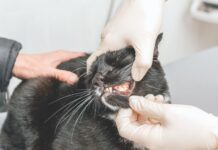Question: I recently noticed that my cat, Squirt, has tiny bumps on his body. I took him to a veterinarian who believed the bumps were due to inhalent allergies. She gave him a shot of medication that she said should last for two to three months. The medication did help, but one month later the bumps were back. She gave him another injection and changed his diet to see if he is allergic to the food he is eating (a premium food I bought because I thought it was the best on the market, but now Im afraid I did something wrong). I dont have the financial resources to take him to a veterinary dermatologist or to change his food to an even more expensive brand. Will giving him one shot every month hurt him?
Answer: Skin questions are always tough to answer without actually being able to examine the kitty in question and having the opportunity to ask questions of the owner, so by necessity Ill have to make some assumptions. The bumps you feel and/or see on Squirts skin are probably the result of a skin condition veterinarians call papulocrustous dermatitis or miliary dermatitis. This is not a diagnosis; rather, these names simply describe what the skin disease is like. The word papulocrustous comes from papule, a small, solid elevation of the skin, and crustous, for crusty or scabby. Miliary is derived from millet seed – apparently what some imaginative veterinarian decided these bumps felt like.
The most common causes of this condition are flea bite hypersensitivity, atopy (also called allergic inhalent dermatitis), food hyersensitivity, cheyletiellosis (skin infestation with the Cheyletiella mite), and ringworm (a disease caused by fungi called dermatophytes). But in truth, there are close to 20 different causes of papulocrustous dermatitis in cats. This makes finding the cause sound like a rather imposing task. But a few simple and inexpensive procedures that your veterinarian can perform in the office will often go a long way towards finding the cause.
A thorough physical examination is of absolute necessity, and particularly close attention should be paid to the skin. Evidence of fleas would prompt one to suspect that flea bite hypersensitivity is the cause, although finding fleas is not absolute proof. Examining the skin with a magnifying lens and evaluating skin scrapings under a microscope will sometimes disclose the presence of other kinds of skin parasites.
Examining a stool sample in the same manner that one checks for intestinal parasites will sometimes reveal bugs on the skin that cats have ingested in the process of grooming themselves. Culturing for dermatophytes (by placing debris from the diseased skin onto a special material that allows fungus to grow) is a necessary and simple thing to do, and collecting some of the material beneath the scabs and examining it under a microscope can also provide extremely valuable information.
If none of these tests provides the answer, there are several diagnostic and treatment options that can be pursued. Let me briefly outline one. (Note: This is not the only option, nor is it necessarily even the best option in all situations.)
Because food hypersensitivity is one of the more common causes of papulocrustous dermatitis, feeding the kitty a novel diet (one that contains ingredients that have not been consumed before) is a very useful test; often such a diet needs to be fed for one to two months before a response is seen. Many of the more successful elimination diets are homemade and reasonably inexpensive. Make sure Squirt eats nothing else during this time. (Even though youve been feeding a diet that is sometimes marketed as hypoallergenic, cats can still become allergic to it. But set your mind at ease: You have not caused any harm to your cat by feeding it.)
Admittedly, circumstances sometimes prohibit owners from performing all the tests necessary to reach a precise diagnosis. There is nothing inherently wrong with trying a corticosteroid (cortisone-like medication), the shot your veterinarian probably gave Squirt, to see if it helps. I would be uncomfortable giving such a medication without performing skin scrapings, a fungal culture, a fecal examination, and attempting to rule out flea problems first, but adverse effects of corticosteroids are fairly uncommon and mild in cats. Even so, long-acting shots shouldnt be given more often than once every two to three months; even then, there is some risk of adverse side effects. If long-term use of a corticosteroid is necessary to control Squirts condition, its best to try to switch to a pill form, preferably one that can ultimately be given every other day.



